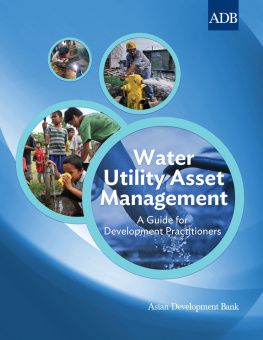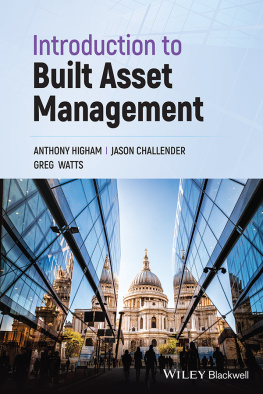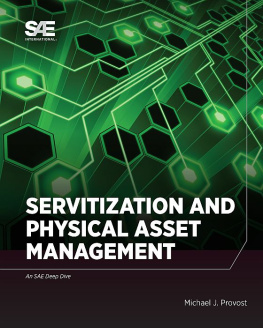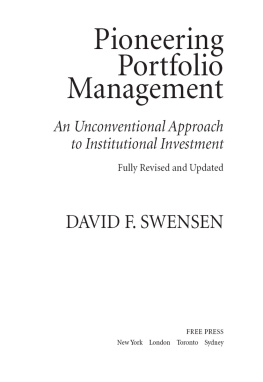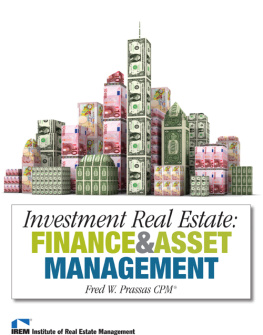Jeremy L. Boerger - Rethinking Information Technology Asset Management
Here you can read online Jeremy L. Boerger - Rethinking Information Technology Asset Management full text of the book (entire story) in english for free. Download pdf and epub, get meaning, cover and reviews about this ebook. year: 2021, publisher: Business Expert Press, genre: Home and family. Description of the work, (preface) as well as reviews are available. Best literature library LitArk.com created for fans of good reading and offers a wide selection of genres:
Romance novel
Science fiction
Adventure
Detective
Science
History
Home and family
Prose
Art
Politics
Computer
Non-fiction
Religion
Business
Children
Humor
Choose a favorite category and find really read worthwhile books. Enjoy immersion in the world of imagination, feel the emotions of the characters or learn something new for yourself, make an fascinating discovery.
- Book:Rethinking Information Technology Asset Management
- Author:
- Publisher:Business Expert Press
- Genre:
- Year:2021
- Rating:3 / 5
- Favourites:Add to favourites
- Your mark:
- 60
- 1
- 2
- 3
- 4
- 5
Rethinking Information Technology Asset Management: summary, description and annotation
We offer to read an annotation, description, summary or preface (depends on what the author of the book "Rethinking Information Technology Asset Management" wrote himself). If you haven't found the necessary information about the book — write in the comments, we will try to find it.
Rethinking Information Technology Asset Management — read online for free the complete book (whole text) full work
Below is the text of the book, divided by pages. System saving the place of the last page read, allows you to conveniently read the book "Rethinking Information Technology Asset Management" online for free, without having to search again every time where you left off. Put a bookmark, and you can go to the page where you finished reading at any time.
Font size:
Interval:
Bookmark:

Rethinking Information Technology Asset Management
Rethinking Information Technology Asset Management
Jeremy L. Boerger

Rethinking Information Technology Asset Management
Copyright Business Expert Press, LLC, 2021.
Cover design by Charlene Kronstedt
Interior design by Exeter Premedia Services Private Ltd., Chennai, India
All rights reserved. No part of this publication may be reproduced, stored in a retrieval system, or transmitted in any form or by any meanselectronic, mechanical, photocopy, recording, or any other except for brief quotations, not to exceed 400 words, without the prior permission of the publisher.
First published in 2021 by
Business Expert Press, LLC
222 East 46th Street, New York, NY 10017
www.businessexpertpress.com
ISBN-13: 978-1-63742-014-0 (paperback)
ISBN-13: 978-1-63742-015-7 (e-book)
Business Expert Press Information Systems Collection
Collection ISSN: 2156-6577 (print)
Collection ISSN: 2156-6593 (electronic)
First edition: 2021
10 9 8 7 6 5 4 3 2 1
To Bob Menke:
You said I should, and I finally did
I wish you were here to see it
Description
Information technology asset management (ITAM) and software asset management (SAM) is hard. Annual IT budget forecasts rarely hold up for the entire year. There are plenty of excuses given:
Untrustworthy reporting from the CMDB or MDR
Unplanned version upgrades or platform refreshes
Unapproved software, license, or cloud computing subscriptions coming due
Unanticipated software license audit penalties
And on, and on, and on
Rethinking Information Technology Asset Management presents a new answer to the problem. Most business leaders and IT managers assume nothing can be done. That these problems are part-and-parcel of modern IT. This book presents a new methodPragmatic ITAMthat offers permanent solutions to the ignored, underpinning issues driving hardware and software cost overruns.
This book is intended for business leaders and IT executives who are tired of missed budget forecasts, unexpected software audit penalties, untrustworthy CMDB or Asset MDR reports, and idea that this is just the way it is.
Keywords
information technology asset management; ITAM; software asset management; SAM; volume license agreement; VLA; software audit; software license position report; configuration management database; CMDB; managed data repository; MDR; pragmatic ITAM; budget; true up; renewal
Contents
If you are the kind of person to read the acknowledgements, then I hope you also dont mind the footnotes sprinkled throughout this book. They are there mostly for levity; to break up a rather dry subject.
First, this book would not be possible without the help of Gillian Singletary. I am the architect and engineer of Pragmatic ITAM, but she is the general contractor, surveyor, carpenter, electrician, plumber, painter, and interior designer. I am no writer by any means, and she deftly accepted the herculean (or, better, Amazonian?) task of converting my dissonant scribbles, notes, slide decks, and recordings, into a proper book. Andrea Dale was so right to connect us to each other!
Second, the good folks at Business Expert Press deserve recognition for the opportunity to put my words to print. Scott Isenberg and Dan Power, Exeter team, producer Charlene Kronstedt, and marketer Sheri Dean, and host of others. Many thanks for seeing the value in my work, patiently guiding me through the publishing process, and putting up with my questions and delays.
Various colleagues and mentors have influenced me greatly in my twenty-plus years as an information technology asset manager. Steven Russman, the executive director of the IBSMA (International Business Software Managers Association), granted my first platform to discuss Pragmatic ITAM back at SAM Summit 2016. Sandi Conrad was there, and over red wine and chocolate-coated bacon, convinced me these ideas should be written down. Matthew Eversole, Linda Androvich, Rick Piatak, and Stephen Forrester, at various times in my career, took a chance on me and allowed me to learn, grow, experiment, test, and refine my craft with each iteration. But it was Bill Harley who started it all, way back in 1999.
I want to especially thank a small group of friends and cohorts who contributed greatly to the creation and refinement of this books content. Robert Cherry, Matthew Curtiss, and Gladys Mason helped lay the groundwork of what would become the Tenants of ITAM. Dr. John A. Lynch, III, offered timely insight and guidance in navigating non-fiction writing. Christopher Rismiller offered his entrepreneurial experience and know-how in starting my own consulting firm. And then Brian McKibben, who offered neither insight nor experience, but plenty of beer and encouragement when this project seemed to go on forever.
Then, to the rest of my family and friends: thank you for all the love and support you have shown me over the years. I would have never written a book without your blessings, and I could not have finished it without all of your encouragement. Stephen, Roger, and Ilsamy childrenthis book doesnt make up for all the missed appointments, late arrivals, and time spent apart; I hope you can forgive me. It is just that all three of you make me so proud to be your father, and I want to accomplish something that would make you just as proud of me.
Finally, lastly, and most important of all, there is Lisa. My love, my darling, my brown-eyed girl.
I was inspired by the great Arthur C. Clark to use footnotes to converse with readers directly. In his Millennium series2001: A Space Odyssey, 2010: Odyssey Two, 2061: Odyssey Three, and 3001: The Final Odysseyare peppered with footnotes talking about the real science behind the plot. Sometimes, the footnotes took up more of the page than the story itself!
The oldest documents to survive antiquity are Sumerian receipts estimated to be 7,000 years old. Written in cuneiform on clay tablets, this documentation has all of the recognizable details one would expect in a modern transfer of custody: who is making the purchase, who is recording it, what kind of stuff and how much, and so on.
It takes little imagination to frame the scene: the scribe, reed stylus in hand (maybe a few spares tucked into his hair) dutifully recording the contents of the transaction, making small talk with the customer, the late summer sun high in the sky, a light breeze signaling autumn is approaching.
Truly, things have not changed much since. Swap that stylus and tablet for their electronic counterparts (no coincidence, they are also referred to as a stylus and tablet). Paper and ink crank out of a receipt printer on the counteror are automatically sent via SMS to the purchaserafter money is exchanged. Our modern scribe is still recording the same data: who is making the purchase, who is recording it, what kind of clothing and how much, where the product originated, and so on.
While the scene might be the same, modern technology has sped up the process. The ancient scribe would have needed to carefully bake his clay tablet to record his work, then filed it away in a document repository near the market for easy retrieval when the kings tax collectors came to visit. Our modern scribe simply presses an onscreen button with her electronic stylus on her electronic tablet and all her work is instantly saved in a database for safekeeping. When the kings collectors ask to audit the market, our ancient scribe would retrieve the germane tablets, calculate all the incomes and outgoings, then produce another clay tablet with all of his notes and calculations. That might take a couple of days or even a week. His modern counterpart has her information and reports in seconds.
Font size:
Interval:
Bookmark:
Similar books «Rethinking Information Technology Asset Management»
Look at similar books to Rethinking Information Technology Asset Management. We have selected literature similar in name and meaning in the hope of providing readers with more options to find new, interesting, not yet read works.
Discussion, reviews of the book Rethinking Information Technology Asset Management and just readers' own opinions. Leave your comments, write what you think about the work, its meaning or the main characters. Specify what exactly you liked and what you didn't like, and why you think so.



